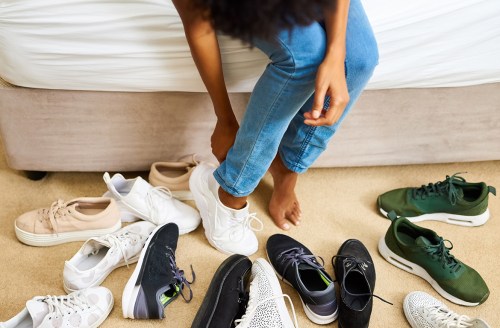When it comes to keeping our bodies healthy, how often do our feet come to mind? Not often. But overlooking the importance of healthy feet can lead to a number of issues that can impact our overall health. The good news? Keeping your tootsies in top shape doesn’t have to be difficult. In 2021, we tapped podiatrists to ensure our feet were well taken care of with foot stretches and more. Below, a comprehensive list of the best tips we’ve accumulated to help keep feet healthy.
Experts in This Article
podiatrist and CEO of Arcus Orthotics
a podiatrist in California
podiatrist and member of the Vionic Innovation Lab
board-certified podiatric surgeon and founder of Gotham Footcare
board-certified podiatrist and founder of Step Up Footcare in New York City
Shop for new shoes at this time of day
Fit, price, and style are key to selecting the perfect shoe. But guess what’s also important when shopping for shoes? Time of day. According to Miguel Cunha, DPM, a podiatrist and the founder of Gotham Footcare, it’s best to try on shoes at the end of the day when your feet are in their worst state. He notes that the feet and ankles swell at the end of the day due to increased pressure and stress of fluid retention in the veins of one’s feet. “If you purchase a pair of shoes that are comfortable at the end of the day, they are more likely to be a comfortable fit throughout the day,” he says.
This test will tell you when it’s time to replace your shoes
We all have that favorite pair of shoes we never want to part with. However, wearing shoes past their expiration date can lead to a host of injuries: sprains, tendonitis, and back pain, among other issues. According to podiatrist Jacqueline Sutera, DPM, the tabletop test will let you know definitively when it’s time to toss your footwear. “Put your shoes on a tabletop and look at them from the back at eye level,” she says. “Examine and compare to see if there are any signs of wear or if they are uneven. Also, flip them over and examine the entire sole surface for other signs of cracking, holes forming, or shoe coming apart.” If the answer is yes, it’s time to say goodbye.
The ‘Goldilocks Rule’ is the blister-proof tip you’ve always wanted
The wrong boot-sock combo can lead to blisters. Look for breathable materials, like cotton and merino wool, says Adam Kaplan, DPM. “[Look for] a cushioned footbed, arch support, and seamless toes.” He recommends the “Goldilocks Rule,” meaning that your socks should be “not too tight, not too loose—just snug enough.” To ensure your socks and favorite boots are a heavenly match, try them out at night (since your feet swell throughout the day, remember?). Bombas, featured here, are a podiatrist-approved pick.
Looking to protect your heel while galavanting in boots? Try foot condoms, aka silicone socks that protect your heels from rubbing against the backs of your shoes. When worn properly, Dr. Sutera says, “these could be helpful to cushion, moisturize, protect and reduce friction and rubbing.”
Overall, here’s how to determine your foot type and what bests suits it
When shopping for a new pair of shoes, how often do you factor in foot type alongside overall style? “To determine your foot type, look at the soles of a pair of worn-in shoes,” says Dr. Cunha. The reason: The wear pattern pinpoints where you accumulate the most pressure when walking.
If your shoes look more worn on the inside, your feet pronate (they roll inward). But if your shoes look more worn on the outside, your feet supinate, or lean outward.
These signs indicate stress in your feet
Our bodies keep the score, so stress can manifest anywhere—and feet are no exception. According to Dr. Sutera, a musculoskeletal response to stress—that is, a reaction in our bones, muscles, tendons, ligaments, and soft tissues—is caused by a flight-or-fight response. Your feet will pinpoint your stress by causing cold feet, numbness and tingling, or decreased flexibility and discomfort. If you experience one or more of these symptoms, here’s how to treat them.
No arch? No problem
Whether inherited genetically or caused by a medical ailment, having high arched feet is common. However, high arches can make your feet more prone to conditions such as plantar fasciitis, which is brought on by pain and inflammation in the bottom of your foot. Also known as “cavus foot,” high arched feet can get exacerbated by wearing the wrong shoe, resulting in issues like Achilles tendonitis; arch pain, or midfoot instability; calluses on the ball of the foot; and hammertoe.
According to podiatrists, when shopping for boots, there are three main characteristics to look out for to ensure you’re sporting a supportive and properly-cushioned boot: the sole should be semi-stiff; it should have at least a one inch heel counter, since the elevated heel can help with reducing the arch strain; and it should have semi-rigid arch contact. (Get more insight here.) If you’d like to prevent purchasing ill-fitting boots or break in a new pair, try these tips.
The best shoe choice for bunions
Another common foot issue is bunions. A bunion forms when your big toe joint shifts out of place, causing a knot on the inside of your foot. While bunions, or hallux valgus deformity, may be caused by a variety of factors, they’re mainly genetic. Additional factors, like being a cis woman, having children, or having rheumatoid and psoriatic arthritis, can increase the chances of developing bunions.
If you have them, shoe choice truly matters. Since the bunion adds width to the forefoot, shoes can put pressure on the bunion, resulting in numbness and tingling in the big toe and worsening its inward motion. To ensure you’re selecting bunion-friendly footwear, opt for shoes that have a wide forefoot, arch support, a slight heel, stretchable fabrics, and fewer than three (or thin) straps. And if you’re experiencing foot pain, try these sneaker brands or stretch with toe separators. While surgery may be the best option in dealing with a bunion, bunion correctors can ease your discomfort and provide a temporary fix while you access how best to treat the issue.
How to find back pain-proof kicks
Back pain can be caused by a number of issues, but your shoes don’t need to be one of them. There’s a proven link between improper footwear and pain in your lower body (think: ankles, knees, hips, and lower back) because your muscles are working overtime to keep you aligned and steady. The key things to remember when shopping for back pain-proof kicks: Shoes need to fit properly (for example, you should have a full thumb’s width of space at the end of your toes in your shoes), select shoes that are the right shape for your feet, and swap flexible shoes for structured, more rigid footwear. Here’s a curated list of podiatrist-approved shoes for back pain.
Don’t forget nail health
Hate to break it to you, but nail polish is a leading cause of toenail fungus, says Doug Tumen, DPM, FACFAS. If you remove your polish and notice white spots, yellow discoloration, or thickening of your nail, you may have a fungus forming. This would be the perfect time to take a break from polishing your nails. Consider buffing your nails for a neutral look or choose nail stickers and decals for a decorative touch. Once your nails return to normal, consider using a different typr of polish. “New anti-fungal, non-toxic nail polish is now available,” Dr Tumen says. “Consider switching to a safe anti-fungal nail polish to help avoid developing fungus toenails.”
To avoid shoe odor, follow these foot care tips
Shoes are the perfect location for odor-causing germs. “The odor in feet is caused by the sweat and moisture ‘fermenting,'” says Dr. Sutera. “It’s actually a byproduct and can be any combination of bacteria, fungus, mold, or yeast.” Slipping your bare feet into a boot or shoe—or even donning socks right after your shower without allowing feet to dry—creates a perfect breeding ground for fungus. Dr. Sutera suggests wearing moisture-absorbent socks and sprinkling your feet with powder (or even applying antiperspirant) to help keep them moisture-free.
Aside from properly washing your feet, wearing socks made of natural fibers, and alternating between shoes (preferably leather) to allow for them to dry out between wears, a black tea foot soak helps with excessive sweating and smells. Simply brew two tea bags in a quart of water, let it cool, and soak your feet for 10 minutes every night for one week. “Once the problem is under control, soaking your feet once a week will keep the odor at bay,” she adds. With foot soaks being super calming, you can try this soothing, $8 podiatrist-approved, aromatic soak.
Tend to your heels with these soothing creams
As the weather turns cold, it’s important to give your feet some extra TLC. Placing pressure on already-dry heels results in cracking, but this can be soothed or prevented with the use of foot creams. Here’s a list of moisturizing, callous-breaking creams.
Calf stretches are the secret to healthier feet
Stretching your feet regularly may seem like a given, but calf stretches may actually be more important when it comes to overall foot health. According to Dr. Sutera, calf stretches (like downward dog and lunges with a straight back leg) lengthen and loosen both the Achilles and plantar fascia. Add a forefoot stretch and a stretch for the ball of your foot to ensure foot pain is a thing of the past. Find out how to do these stretches here.
Support for flat feet (and those who lift)
It’s time we stop giving flat feet a bad wrap. It’s not a foot condition, just a type. “This type demonstrates small-to-no arch, a wide foot base, and an inward angled heel,” shares podiatrist Nelya Lobkova, DPM. “A flat foot type requires the shoe to be wide enough at the ball of the foot and supportive in the midsole or arch of the foot to limit the collapse of the arch.”
While it’s best to get a customized recommendation from a podiatrist, Dr. Lobkova suggests wearing stability running and walking shoes. Stability shoes provide midfoot stability and support, which establishes normal toe-off gait. You’ll find that running sneaker brands offer a stability category. Keep in mind, if you plan to do strength training or cross training, you’ll also need a shoe with a wide toe box and good traction in the outsole, which helps maintain muscle control during lateral movement. Get a few hand-picked shoe suggestions here. And, for those into strength training, you’ll want to see why Converse sneakers are the ideal weightlifting shoes.
This one pair comes highly recommended
The Asics Gel Kayano is a match for everyone, says Dr. Cunha, who recommends the lightweight-yet-durable shoe daily. But runners will enjoy it most. Designed with rearfoot and forefoot next-gen gel technology, it provides shock absorption and exceptional cushioning. It also boasts increased motion control and is designed to decrease tension placed on your plantar fascia and Achilles tendon.
For those with neutral feet, the podiatrist recommends The Asics Gel Nimbus 22. “This shoe is the softest, lightweight, and flexible shoe as it can bend and twist more in the middle of the shoe,” he says. He provides his go-to running shoes for neutral feet here, and a lightweight, breathable rocker-style sneaker that’ll help any runner log faster miles.
These particular tips will land you running shoes for wide or narrow feet
Finding the right running shoe can save you a great deal of stress, plus your entire body will thank you. That’s why running shoes that fit the width of your foot are so helpful.
Diane Koshimune, DPM, advises looking for running shoes that allow the entire bottom of your foot to adequately fit over the base of the shoe without spilling over the sides of the shoe. Her recommendations for wide feet include shoes from Hoka One and New Balance. It’s quite possible that your foot doesn’t fit solely into one width category, which would mean you’d have to look at the overall construction of the shoe in addition to the wide-narrow categories. She suggests Saucony for wide-ball, narrow-heeled feet. For those with narrow feet, you’ll want to pick a sneaker that truly fits. How will you know? “When you’re able to tighten the laces enough for the shoe to stay put while running,” she says. Here are more picks and tips, like how to get measured for a wide running shoe.
Avoid these 5 shoe styles
High heels aren’t the only shoe to avoid, unless it’s for the occasional strut on the town. There are a few other unsuspecting styles that aren’t ideal for your feet. According to Dr. Cunha, the five worst shoe styles for your feet are ankle boots with a stiletto heel, cowboy boots, slides, slingback flats, and sock sneakers. In the summer months, we swap close-toed shoes for flip flops, sandals and certain types of sneaks, but here’s why you should be mindful of what you place on your feet during the season.
Sorry, add Crocs to the cute-yet-unsupportive shoe trend list
Someone has to say it. Crocs can be doing more harm than good to your feet…especially if you’re wearing them all day. According to Dr. Cunha, the lack of support may have you trying to grip the shoes with your toes to keep them from slipping off, which can cause a bevy of issues including tendonitis, bunions, hammertoes, nail problems, and painful corns and callouses. Compiled by podiatrists, this comprehensive list will lead you to the perfect shoe for any occasion. If you’re looking for the ease that your Crocs provide, you’ll want to try one of these slip-on sneaker styles.
Meanwhile, your feet deserve these arch-supporting sandals
Finding the perfect sandal can be challenging, particularly if you’re shopping for style, comfort, and overall foot health. Dr. Cunha advises you to pay attention to a sandal’s arch, heel, and width before adding it to your shopping cart. Why? Well, sandals without a built-in arch can contribute to pronation (an excessive inward rolling of your feet when you walk) and collapse of the arch, which may lead to plantar and posterior heel pain, knee pain, shin splints, and back pain. Now you know.
When it comes to the heel, seek a platform; but, if you must have a heel, aim for no more than a 3/4-inch heel to reduce stress on the Achilles tendon. And, to prevent foot problems, ensure you have enough space for your forefoot in your shoes.
Speaking of support, try these insoles
We’ve all been there. You’re walking in a fly pair of shoes, then, suddenly, you feel pain. You want to give that pair another try, but know you need a touch of support to make it a worthwhile do-over. Here’s where orthotic insoles come in.
Designed to provide comfort and relief from foot pain (and help to prevent future injuries), orthotics are “an affordable and non-invasive way to address common foot issues including heel pain, plantar fasciitis, bunions, flat feet, knee pain, back pain, and more,” says Dr. Kaplan. While orthotics come in all shapes and sizes to fit any foot type, activity, concern, and shoe, they either come as over-the-counter or custom. The latter are made with your specific foot type, along with all of its intricacies, in mind. Here are a few custom orthotics options.
Oh hi! You look like someone who loves free workouts, discounts for cutting-edge wellness brands, and exclusive Well+Good content. Sign up for Well+, our online community of wellness insiders, and unlock your rewards instantly.
Sign Up for Our Daily Newsletter
Get all the latest in wellness, trends, food, fitness, beauty, and more delivered right to your inbox.
Got it, you've been added to our email list.











